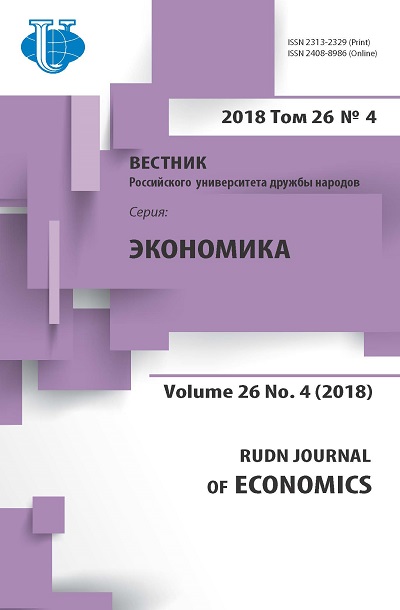Cash innovations and digital economics: reaction of the state, society and universities
- Authors: Bystryakov A.Y.1, Nenovsky N.2, Ponomarenko E.V1
-
Affiliations:
- Peoples’ Friendship University of Russia (RUDN University)
- Université de Picardie Jules Verne
- Issue: Vol 26, No 4 (2018)
- Pages: 742-759
- Section: WORLD CAPITAL MARKET
- URL: https://journals.rudn.ru/economics/article/view/20766
- DOI: https://doi.org/10.22363/2313-2329-2018-26-4-742-759
Cite item
Full Text
Abstract
The article is devoted to the study of theoretical approaches to the content and functions, as well as the results of the introduction of modern digital financial innovations (cryptocurrencies, blockchain technologies) into modern financial and economic circulation in various countries of the world. It analyzes the positions of government structures, central banks of different countries in relation to challenges and risks, on the one hand, and progressive changes that accompany the introduction of digital technologies in financial and economic relations, and also discusses some of the prospects for the global monetary system. A special place in building the architecture of the new global financial system is given to higher education, modern universities that can implement training for the new economy and social sphere. The analysis allows to draw conclusions about the active role of the state, the structures of civil society in the adaptation of the population to the challenges of the information revolution.
About the authors
Alexander Ya Bystryakov
Peoples’ Friendship University of Russia (RUDN University)
Author for correspondence.
Email: bystryakov-aya@rudn.ru
Doctor of Economics, Professor, Head of Department of Finance and Credit of the Economic Faculty of the Peoples’ Friendship University of Russia (RUDN University).
6 Miklukho-Maklaya St., Moscow, 117198, Russian FederationNikolay Nenovsky
Université de Picardie Jules Verne
Email: nikolay.nenovsky@u-picardie.fr
Doctor of Economics, Professor at Jules Verne University of Picardy
Chemin du Thil - CS 52501 - 80025 Amiens Cedex 1, FranceElena V Ponomarenko
Peoples’ Friendship University of Russia (RUDN University)
Email: ponomarenko-ev@rudn.ru
Doctor of Economics, Professor, Head of Department of Political Economy of the Economic Faculty of the Peoples’ Friendship University of Russia (RUDN University)
6 Miklukho-Maklaya St., Moscow, 117198, Russian FederationReferences
- Lskavyan D.N., Fedorov A.V. (2014). Bitkoin chastnaya kriptovalyuta ili platezhnoe sredstvo postkapitalisticheskoj sistemy global’nogo mira. Russ. acad. j., RAJ. No. 1. Pp. 46—49. (In Russ.)
- VC.ru. Uzhe ne prosto trend: obzor tekhnologij i produktov na osnove blokchejn. https: // vc.ru/p/ blockchain-conference (In Russ.)
- Prosto investicii. Kriptovalyuta v Rossii. Zarozhdenie i razvitie rossijskoj kriptovalyuty — rucoin. http: // prostoinvesticii.com/o-dengakh/kriptovalyuta-v-rossi-zarozhdenie-i-razvitie-rossijjskojjkriptovalyuty-rucoin.html (data obrashcheniya: 05.03.2016) (In Russ.)
- Ishmuradova I.I., Ishmuradova A.M. (2015). Infrastruktura informacionnoj sistemy kak vazhnyj ehlement upravleniya promyshlennym predpriyatiem v innovacionnoj ehkonomike. Prioritetnye napravleniya razvitiya i ehkonomicheskaya bezopasnost’ Rossijskoj Federacii. Sbornik statej II Mezhdunarodnoj nauchno-prakticheskoj konferencii. Vyp. II. Pp. 47—52 (In Russ.) Guichard J-P. L’Etat-parti chinois et les multinationales. Le Harmattan. Paris.
- Lakomski-Laguerre O., Desmedt L. (2015). L’alternative monétaire Bitcoin: une perspective institutionnaliste. Revue de la régulation.
- Cohen B. (2015). Currency Power. Understanding Monetary Rivalry. Princeton: Princeton University Press.
- Cohen B. (1998). The Geography of Money. Ithaca. NY: Cornel University Press.
- Song H. (2013). La guerre des monnaies: La Chine et le nouvel ordre mondial. Le Retour aux Sources. Paris.
- Banque de France. (5 mars 2018). L’émergence du bitcoin et autres crypto-actifs: enjeux, risques et perspectives. Focus.
- Carney M. (2018). The future of Currency. Inaugural Scottish Economics Conference, Edinburgh University, 2 March 2018.
- Korjus K. (2017). We’re planning to launch estcoin — and that’s only the start. Medium. Podcast. https://medium.com/e-residency-blog/were-planning-to-launch-estcoin-and-that-s-only-thestart-310aba7f3790
- Nenovsky N. (2009). On Money as an Institution (A review essay on Luca Fantacci’s book La Moneta: Storia di un’istituzione mancata). ICER Working Paper No. 12/2009. Torino.
- He D., Leckow R., Haksar V., Griffoli T., Jenkinson N., Kashima M., Khiaonarong T., Rochon C., Tourpe H. (2017). Fintech and Finance Services: Initial Considerations. IMF Staff Discussion Note 17/05. IMF.
- Eichengreen B. (1992). Golden Fetters: The Gold Standard and the Great Depression 1919—1939. Oxford University Press, New York.
- Petro. White Paper. Financial and Technological Proposal (March 15, 2018). Gobierno Bolivariano di Venezuela. http://www.elpetro.gob.ve/pdf/en/Whitepaper_Petro_en.pdf
- Floyd D. (February 22, 2018). Venezuela’s Petro Isn’t Oil-Backed. It’s Not Even a Cryptocurrency (Opinion). https://www.investopedia.com/news/venezuela-petro-not-cryptocurrency/ #ixzz5EcpJSpz1
- Genkin A. (2018). Blokchejn. Kak ehto rabotaet i chto zhdet nas zavtra. Moscow: Al’pina Publ. (In Russ.)
- He D. (June, 2018). Monetary Policy in the digital age. Crypto assets may one reduce demand for central bank money. Finance and Development. IMF. Pp. 14—16.
- Bouveret A., Haksar V. (June, 2018). What are cryptocurrencies? A potential form of money offers benefits while posing risks. Finance and Development. IMF. Pp. 26—27.
- Adriano A. (June, 2018). A short history of crypto euphoria. Finance and Development. IMF. Pp. 20— 21.
- Ingves S. (June, 2018). Going cashless. Finance and Development. IMF. Pp. 11—12.
- Woodford M. (2000). Monetary Policy in a World without Money. International Finance. No. 3 (2). Pp. 229—260.
- Dubyanskij A. (2017) Teorii proiskhozhdeniya deneg i kriptovalyuty. Den’gi i kredit. No. 12. Pp. 97—100. (In Russ.)















